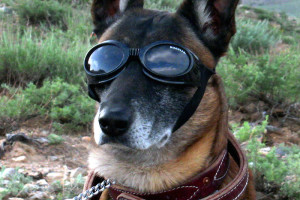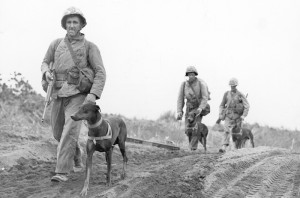Wcag Heading
by Rebecca Frankel
Wcag Heading
Chapter 9: The Never Again Wars
In World War II, it is said that war dogs saved 15,000 men. In Vietnam, the dogs were credited with saving the lives of 10,000 men, but many handlers who served there feel that this number is grossly underestimated. Of approximately 87,000 missions, the dogs uncovered 2,000 tunnels and bunkers and enabled 1,000 enemy captures and 4,000 enemy kills.
How big that number will be many years from now, when we are in a position to tally the lives saved by war dogs in Iraq and Afghanistan, one cannot say. But Technical Sergeant Justin Kitts was awarded his Bronze Star in 2011 for his detection work with Dyngo during their Afghanistan deployment, and for having secured the lives of 30,000 US, host nation, and coalition forces. And that was just for one dog team on one tour of duty. Equally impossible to tally are the lives that have been recovered, even in some small way, by a dog’s cathartic presence, on a battlefield or in a wounded warrior treatment center.

Image is in the public domain via Task & Purpose
From war to war, these numbers are often forgotten.
It is an unfortunate scenario that’s already played out twice in the United States: post–World War II and post-Vietnam. The value of war dogs has been lost as often as it has been found.
These events usually go a little something like this: the United States engages in a conflict. Someone, a person or group, with great resilience and spirit, petitions the military to adopt a canine fighting force, touting their many lifesaving skills. Someone in a position of power gives an order, and a small contingent of dogs is procured, trained, and deployed. Once in- country, the dogs prove to be of great value on the battlefield and save many lives. Next comes an “urgent need” request from the combat arena: “Send more dogs!” And so efforts are pooled, handlers and dogs are trained with fervor and speed. Sometimes concessions are made, sometimes shortcuts are taken, but more dogs are sent to war. The military parades the dogs’ successes, the media seizes upon their stories, and headlines capture the hearts of civilians at home.
The wars slow down and eventually end. The tremendous canine force is scaled back, as are the combat-ready aspects of the dog programs, until they are virtually nonexistent.
Read more about War Dogs here
If the war was unpopular, the lessons are lost all the more quickly. This tendency of the US military to strategize with a selective memory is one with which John Nagl, coauthor of the Counterinsurgency Field Manual along with Generals David H. Petraeus and James F. Amos, is well familiar.
The Pentagon is traditionally accused of preparing for the last war. But according to Nagl, who was an operations officer of a tank battalion task force during the Iraq War, that’s not exactly what happens. We prepare to refight the last war only if it was the kind of war we had wanted to fight. The wars the US military is interested in fighting again are wars where they’ve had success, such as the American Civil War and World War II.

Image is in the public domain via Task & Purpose
The irony of this, Nagl explains to me, is that in recent decades, the American military hasn’t spent its time fighting big and successful wars like these. Instead, we have fought small wars, irregular wars—the kind of wars waged with IEDs. Despite this reality, the military still builds the capabilities it needs for those “big” wars, not the capabilities it needs for what Nagl calls the “small nasty wars of peace.”
And when the military tries to do that, it makes mistakes, which is when the lessons learned become especially important. In fact, Nagl says, “we have rediscovered many, many lessons that we actually learned and paid for in great cost in Vietnam.” One of those lessons, Nagl says, “is the utility of working dogs, who were invaluable in Vietnam. [We] couldn’t get enough of them; didn’t ever have enough of them.” But after Vietnam, he says, the skills of those war dogs, as with almost everything about Vietnam, was purged from our memory. “And that’s a lesson we had to relearn. We are in danger of forgetting a number of those lessons,” Nagl tells me. And that includes the dogs.
In the years following the Vietnam War, the US military began to disassemble its war dog programs little by little, dismantling ten years of combat readiness. In a shroud of shame, the dog programs slipped away—first the tracker dogs, then the scout dog school at Fort Benning. There was no outside organization watching over the military efforts for the war dogs deployed to Vietnam as there was in World War II.

Image is in the public domain via Task & Purpose
The Vietnam chapter, which will remain a perpetual blemish in the United States’ war dog history, is perhaps the most troubled and difficult to reconcile. But each war has its own dogs—from the Revolutionary War to Vietnam—and each war has its own saga. How the dogs came in, and how they came out again, is as important, in some ways, as what they did while they were there. Their entry and exit unearths a relevant truth. This discernible pattern of US war dog history is one of building to a great success that is later shelved and forgotten, only to be rebuilt again when the need arises. It’s a precedent that creates the kind of disadvantage no one would be able to fully realize until 2004, when it was time to send the dogs back to war, so many years after Vietnam.
Rebecca Frankel is deputy editor at Foreign Policy. She is the author of War Dogs: Tales of Canine Heroism, History, and Love a New York Times bestselling book about canines in combat, the subject of her regular Friday column “Rebecca’s War Dog of the Week,” featured on The Best Defense. Her work has appeared in The Wall Street Journal, The Atlantic, National Geographic, Slate, The Washington Post, and elsewhere. Most recently, Frankel has been as a guest on Conan O’Brien, BBC World News, and the Diane Rehm Show among others.
